THE TECHNOLOGY

Although foiling feels like a recent revolution to take the world of watersports by storm, it has been at the heart of America’s Cup racing for 10 years. It was August 2012 when the sailing world was turned upside down by a 72- foot catamaran flying in the Hauraki Gulf. Emirates Team New Zealand had brought foils to the America's Cup, changing the face of top-level yacht racing forever. Six years later, in 2018, the publication of the AC75 Class Rule marked the beginning of a new sailing era. The engineering and sailing techniques needed to get the AC75 to fly were completely different from anything seen before. During the 36th America's Cup in 2021 the AC75 proved themselves to be unique and kept millions of fans worldwide glued to their screens.
Therefore On the 15th of November 2021, eight months after Emirates Team New Zealand successfully defended the America's Cup, an updated 'Version 2' of the AC75 Class Rule was released. The foiling monohulls to be used in Barcelona in 2024, will be slightly different, with rules being tweaked partly to improve light wind performance and reduce crew numbers from 11 to 8. The move to reduce the crew means cycle power is again legalised, and the cyclors, introduced by Team New Zealand in 2017, might return in the game. But what's the technology behind the AC75?

Therefore On the 15th of November 2021, eight months after Emirates Team New Zealand successfully defended the America's Cup, an updated 'Version 2' of the AC75 Class Rule was released. The foiling monohulls to be used in Barcelona in 2024, will be slightly different, with rules being tweaked partly to improve light wind performance and reduce crew numbers from 11 to 8. The move to reduce the crew means cycle power is again legalised, and the cyclors, introduced by Team New Zealand in 2017, might return in the game. But what's the technology behind the AC75? To start with, the AC75 is big - 75-feet long and 16-feet wide - but, it's also light, which is crucial, because the AC75 is designed to fly. It's also different - rather than a keel, a brand new concept keeps it standing. Foil Cant Arms move under, or outside, the boat to provide the leverage it needs to stay upright. Some parts of the boat are supplied - the mast, rigging, foil-cant arms and their hydraulics are all stock components. But, there are still plenty of areas that designers can experiment with to find a race-winning edge. The double-sail skin Mainsail combines with the D shaped mast to form a wing, generating the power the AC75 needs to foil. Underwater is where things get really interesting, the foil cant system is a battery-driven, hydraulic power-unit that supplies the energy to lift and lower the immensely strong - and heavy - foil cant arms. As the boat swaps tacks, the cant system is activated, placing one hydrofoil in the water, and lifting the other one out, where its weight becomes ballast. At the end of the arms lie the teams' secret weapons - the foil wings. Apart from basic rules governing dimensions and weight, these are open territory for designers. With the teams allowed to build only one AC75, will a lot change from what we have seen during the last Cup, or will the new monohulls resemble the winning Kiwi boat?
- New Sailboats
- Sailboats 21-30ft
- Sailboats 31-35ft
- Sailboats 36-40ft
- Sailboats Over 40ft
- Sailboats Under 21feet
- used_sailboats
- Apps and Computer Programs
- Communications
- Fishfinders
- Handheld Electronics
- Plotters MFDS Rradar
- Wind, Speed & Depth Instruments
- Anchoring Mooring
- Running Rigging
- Sails Canvas
- Standing Rigging
- Diesel Engines
- Off Grid Energy
- Cleaning Waxing
- DIY Projects
- Repair, Tools & Materials
- Spare Parts
- Tools & Gadgets
- Cabin Comfort
- Ventilation
- Footwear Apparel
- Foul Weather Gear
- Mailport & PS Advisor
- Inside Practical Sailor Blog
- Activate My Web Access
- Reset Password
- Customer Service

- Free Newsletter


Catalina 42 Mk I and Mk II
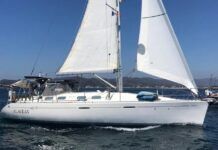
Beneteau First 42s7 Used Boat Review

Pearson 303 Used Boat Review

Grampian 26 Used Boat Review

Vesper Marine WatchMate 850 and Icom M91D: Where Credit is Due

How to Create a Bullet-Proof VHF/SSB Backup

Tips From A First “Sail” on the ICW
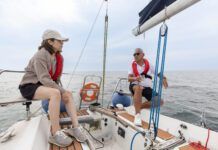
Tillerpilot Tips and Safety Cautions
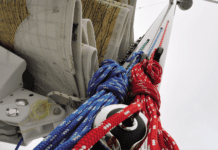
Bulletproof Splice for Reeving New Halyards

Haul Out Tips to Avoid Confusion and Delays

Checking Rope Strength

Lashing for Strength

Ensuring a Safe Space for Batteries
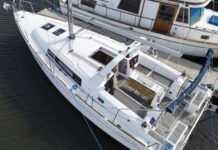
Impact of Modern, Triangular-Design on Boat Performance
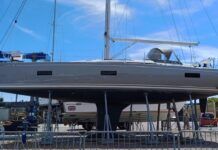
Keel and Rudder Design Basics

Diesel-Electric Hybrids Vs. Electric: Sailing’s Auxiliary Power Future
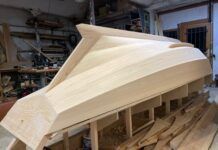
Wooden Boat Revival: Can Boatbuilding Be Regenerative?
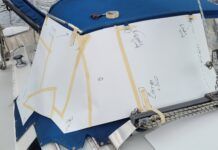
How to Make Dodger Cover Canvas Pattern

How Much Does It Cost to Keep a Boat on the…
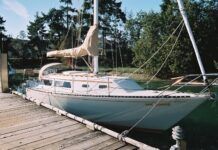
Insurance For Older Sailboats

PS Advisor: Acid Cleaning Potable Water Systems

Product Hacks: Velcro, Bounce, Anti-Skid Mats and Pool Lights

Stopping Holding-tank Odors
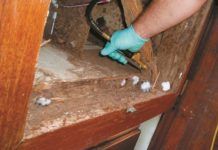
Giving Bugs the Big Goodbye

Compact Scuba Kits for Sailors

Cold Weather Clothes to Extend the Sailing Season
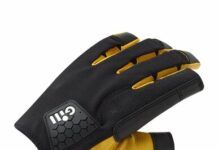
Five Best Gloves: Sailing and DIYing in All Weather

Sailing Gear for Kids

Bilge Pump Installation and Maintenance Tips

Full-Time Ocean Trash Cleanup in the Arctic Circle

Boats That Fly? How High Tech Rocked the America’s Cup

R. Tucker Thompson Tall Ship Youth Voyage

On Watch: This 60-Year-Old Hinckley Pilot 35 is Also a Working…
- Inside Practical Sailor
- Subscriber Only
Between complex aero- and hydrodynamics, space-age materials, and advanced electronic systems, the AC75s vying for sailing’s oldest prize have turned science fiction into science fact.
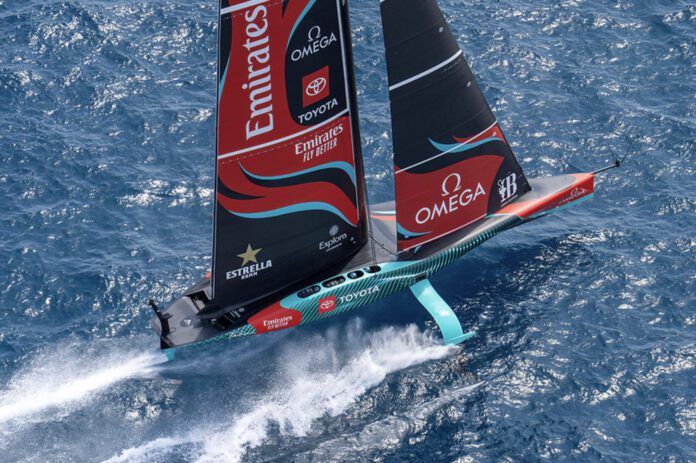
The America’s Cup is an ornate bottomless, sterling silver ewer crafted in 1848 by Garrard's of London—who still repair it when needed. It’s an impressive piece of classic craftsmanship, but it is the only thing that hasn’t changed since this nautical battle royale began in 1851. One-hundred, seventy-three years ago, no one imagined yachts racing for the America’s Cup would be flying above the water in barely 6 knots of wind.
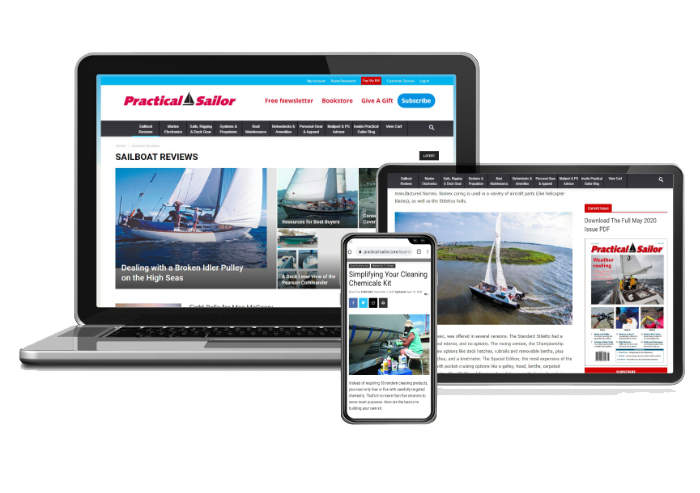
Subscribe to Practical Sailor
Already subscribed, related articles more from author.
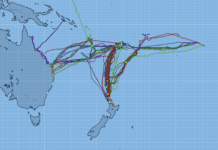
Top 6 Tips for Pacific Rally Cruising
All this technology and it’s as exciting as watching someone else play a video game.
LEAVE A REPLY Cancel reply
Log in to leave a comment

Latest Videos

The SHOCKINGLY Comfortable Million Dollar Sailboat From Moody

New Sailor CRASHES and Needs Advice!

The 50 Foot Carbon Fiber Catamaran From Carbon Ocean Yachts

How To Get Sailboat Insurance
Latest sailboat review.
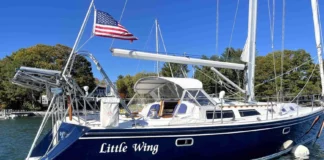
- Privacy Policy
- Do Not Sell My Personal Information
- Online Account Activation
- Privacy Manager

- AMERICA'S CUP
- VENDÉE GLOBE
- CLASSIFIEDS
- NEWSLETTERS
- SUBMIT NEWS
-202411130502.png)
America's Cup - Dan Bernasconi explains the foiling AC75 - Part 1

Related Articles

Hydrofoiling History ♆ The Birth of Foiling in the America’s Cup
Published by sciō on june 13, 2024 june 13, 2024.
In 2013 the America’s Cup went foiling as Oracle Team USA beat Emirates Team New Zealand both sailing foiling 72ft catamarans, the AC72s.
The AC72 (America’s Cup 72 class) is a class of hydrofoiling wingsail catamarans built to a box rule, which governs the construction and operation of yachts competing in the 2013 Louis Vuitton and the America’s Cup races. The class was subsequently replaced by the smaller AC50 class.
There had been many months of secretive R&D meetings at Emirates Team New Zealand that went into developing a concept that would transform the world of America’s Cup racing forever.
Rewind to 2011, two years out from the 34th America’s Cup in San Francisco. A time of any campaign where teams are thinking outside the square with weird and wonderful ideas having been studying the AC72 class rule, looking for loopholes and testing or attempting to validate some of the most innovative theories. A crazy concept was continuing to circle within Emirates Team New Zealand.
“What if we could make the AC72 catamaran fly above the water?”
The America’s Cup is a sailing competition and the oldest international competition still operating in any sport. America’s Cup match races are held between two sailing yachts: one from the yacht club that currently holds the trophy (known as the defender) and the other from the yacht club that is challenging for the cup (the challenger).
The winner is awarded the America’s Cup trophy, informally known as the Auld Mug. Matches are held several years apart on dates agreed between the defender and the challenger. There is no fixed schedule, but the races have generally been held every three to four years. The most recent America’s Cup match took place in March 2021.
For more information on history and upcoming 37th America’s Cup foiling catamaran race visit https://www.americascup.com/
For more information on early America’s Cup hydrofoiling developments check at https://emirates-team-new-zealand.americascup.com/en/news/378_THE-UNTOLD-STORY-OF-THE-BIRTH-OF-FOILING-IN-THE-AMERICAS-CUP.html
Related Posts

Hydrofoiling Innovation ♆ Blue Orca Marine – Canadian Zero-emission Foiling Vessel
Blue Orca Marine is a pioneering Canadian Indigenous-owned company, leading the way in environmentally responsible and sustainable marine solutions. ORCA is a ground-breaking multi-purpose hydrofoil vessel, powered by zero-emission hydrogen technology. This foiling vessel not Read more…

Hydrofoiling History ♆ Hydrodrome by Alexander Graham Bell
One of the earliest hydrofoil accounts is credited to Thomas Moy, an English engineer who in 1861 installed a set on a boat in the Surrey Canal and noted that when the vessel was towed, Read more…

Hydrofoiling Innovation ♆ Ride the Tyde Open – Foiling Luxury Yacht
World’s largest foiling motor yacht is set to launch this year. This foiling vessel measures 14.7m (48ft 3in) overall, has a maximum beam of 4.5m (14ft 9in) and has a potential top speed of 30 Read more…

Hydrofoil Control: How to Stay on Foil

Improve Engineering Value

- 8010 Project Management
- 8200 Fluids
- 8210 Fluid Dynamics
- 8400 Seakeeping / Fluid Structure Interaction
- 8430 Ship Motion Control
- 8440 Ship Maneuvering
- 8450 Fluid Loads
- America’s Cup 2013
- America’s Cup Class
- heave stability
- pitch stability
- surge stability
- sway stability

America’s Cup Hydrofoils: Dangers and Solutions
1.0 the joy of hydrofoil sailing.
“The feeling for me of foil is like flying. When you start gaining speed on a small plane, and then instantly take off and leave the ground. It’s very similar on a boat” -Jimmy Spithill, Skipper Oracle Team USA 2014 [1]
No discussion of hydrofoils is complete without addressing their application to the 2013 America’s Cup yachts. Catamarans screamed across the ocean, flying on innovative hydrofoils. (Figure 1‑1) The crew constantly struggled to balance the foils against the wind and extract every last point of speed. It made excellent drama and energized the sport. But with all that excitement, we sometimes forget how the crew jeopardize their lives in every race.
DMS engineers seek to preserve life while pushing for new innovation and greater achievements. This article presents an engineering perspective on the America’s Cup hydrofoils of 2013, with options for improvement.
2.0 Control of Sailing Hydrofoils
Hydrofoils work fine on sailing vessels; we possess the knowledge to design a stable sailing vessel with hydrofoils. (See article on hydrofoil control .) The roll stability under hydrofoils reacts similar to a normal displacement yacht. Under wind forces, the yacht heels over. This changes the angle and submersion of the hydrofoils. Various systems of control react and adjust the foil forces to balance the heeling moment. On a tack, the vessel switches direction of heel, and the foil on the opposite side takes control. The opposite side foil . . .
We encounter a stability problem with racing hydrofoils in the 2013 America’s Cup. These yachts target extreme performance. In pursuing those extremes, the yachts include the ability to retract the windward hydrofoil from the water. It improves the speed, . . . and it eliminates any passive stability in the foil system. By all rights, the yacht should fall off foil at that point.
The only thing that sustains foil flight in this unstable condition is the crew. They carefully balance the heeling moment of the wind against the hydrofoils. This is equivalent to balancing on a high wire, while someone keeps shaking the wire. While running at 40 – 60 knots. Used in this fashion, sailing hydrofoils are inherently unstable, always trying to fall off of foil.
3.0 Risk of Sailing Hydrofoils
The challenge of sailing hydrofoils adds to the fun, but as an engineer, I focus on the large increased risk to life. Sadly, those risks already progressed beyond theory. While training for the 2013 America’s Cup, sailor Andrew Simpson was killed. [2] The yacht capsized, and Mr. Simpson became trapped under the solid sections of the yacht. Emergency divers failed to locate him in time. The vessel owners prepared for the potential of a capsize with a myriad of safety features [3]:
- Knives to cut free of rigging
- Emergency oxygen bottles
- Underwater training for all crew
- Emergency divers always ready
As an engineer, this tells me that the racers were not reckless; they cared about safety. But those preparations were not enough. I accept that extreme sportsmen demand new challenges, but I can’t accept that a sport warrants jeopardizing your life.
Max Sirena added: “The boat is basically too powerful. At the same time, this is our sport. This is a risk we take.” [2]
Beyond all other requirements, ships must protect the lives of their crew and passengers. The current designs for sailing hydrofoils disappoint in this area. But we don’t throw in the towel and forget about hydrofoils. Engineering gives us the tools to work the problem and develop new solutions. Maybe the vessels protected against the wrong challenge. We need to understand the fundamental risk of sailing hydrofoils.
4.0 The Problem of Speed
The basic problem is the speed inherent to hydrofoil sailing. If a small dinghy capsizes at 5 knots, the consequences are minor. But capsizing at 40+ knots carries a much higher chance of injury. As a heuristic comparison, Figure 4‑1 indicates fatality rates, compared to ship speed. Although this was based on pedestrian collisions with motor vehicles, it shows much more severe danger above 30 knots.

5.0 Design for Capsize
The combination of instability and extreme speed mean too high of a risk. No one wants to remove the hydrofoils. Members of the racing industry desire that challenge of the hydrofoil instability. In that case, we need to accept and anticipate more crash stops and capsizes. If we want yachts designed like fighter jets, give the crew the protection of a fighter jet:
- Five point harness restraints in cockpit
- Fully enclosed cockpit to protect against capsize
- Watertight cockpit with emergency air supply
- Safety systems that engage even if crew are unconscious
- Bottom escape hatch to prepare for capsize
- Failsafe design in the sail rigging
At DMS, we do not see engineering as an obstruction to new challenges. Engineering gives us the tools to try new ideas and evolve them into safe technology. With the proper planning and risk management , we can implement hydrofoil sailboats in a safe manner.
6.0 References
| [1] | Scuttlebut Sailing News, “Americas Cup Hydrofoils 101,” Sucttlebut Sailing News, 13 July 2016. . Available: https://www.sailingscuttlebutt.com/2016/07/13/americas-cup-hydrofoils-101/. . |
| [2] | C. Clarey, “Olympian Dies in America’s Cup Training After Yacht Flips,” pp. https://www.nytimes.com/2013/05/10/sports/sailor-andrew-simpson-dies-in-americas-cup-accident.html, 9 May 2013. |
| [3] | BBC Sport, “Andrew Simpson: America’s Cup Chiefs to Investigate Capsize,” p. https://www.bbc.com/sport/sailing/22489611, 10 May 2013. |
| [4] | W. A. Leaf and D. F. Preusser, “Literature Review on Vehicle Travel Speeds and Pedestrian Injuries Among Selected Racial/Ethnic Groups,” Preusser Research Group, Inc. Contract DTNH22-97-D-05018, Trumbull, CT, USA, October 1999. |
| [5] | G. Hearn, “Course Lecture Notes: “Advanced Marine Vehicles, Hydrofoils”,” in , Southampton, UK, 2006. |
| [6] | E. V. Lewis, Principles of Naval Architecture, Vol II, Resistance Propulsion and Vibration, 2nd Revision, Jersey City, NJ, USA: Society of Naval Architects and Marine Engineers, 1988. |
| [7] | J. Clarke, “Six-Degrees of Freedom,” John Clarke Online, 18 Dec 2011. . Available: https://johnclarkeonline.com/2011/12/18/six-degrees-of-freedom/. . |
| [8] | N. Thompson, “13.5 m Foil Assisted Power Catamaran – Noah Thompson Design,” Noah Thompson Design, 18 Mar 2015. . Available: https://youtu.be/Ss0CDKhPEb4. . |
| [9] | Wikipedia Authors, “PHM-4.jpg,” Wikimedia Commons, 26 Dec 2005. . Available: https://commons.wikimedia.org/wiki/File:PHM-4.jpg. . |
| [10] | G. Waller, “Fresh to Frightening Crashing Moments at the 34th America’s Cup,” YouTube, 15 Sep 2013. . Available: https://www.youtube.com/watch?v=hhZpCK8kwds. . |
Related posts

Figure 3-1: Icebreaker Healy [4]
Surviving the Arctic: Polar Class Icebreakers

Figure 2-1: Icebreaker Mackinaw in Sea Ice [3]
Ramming the Ice: Icebreaker Propulsion

Ever Given Maneuvering Options
Ever Given: Maneuvering Options

Ever Given: What We Don’t Know

America’s Cup Hydrofoils 101
Published on July 13th, 2016 by Editor -->
The hightech catamarans that are competing nowadays in the America’s Cup don’t have anything in common with ordinary boats. The so-called “hydrofoils” allow them to fly. Oracle Team USA, the title defenders of the America’s Cup, describe the process of “foiling” and name the advantages of it during a race. Video published on Jul 13, 2016.

Tags: America's Cup , foiling , Jimmy Spithill , Oracle Team USA
Related Posts

37th America’s Cup was amazingly boring →

Confirmation of AC38 venue by June 2025 →
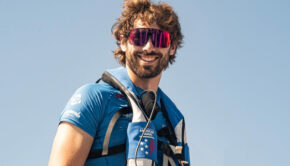
America’s Cup competitor dies at 27 →

Planning begins for 38th America’s Cup →
© 2024 Scuttlebutt Sailing News. Inbox Communications, Inc. All Rights Reserved. made by VSSL Agency .
- Privacy Statement
- Advertise With Us
Get Your Sailing News Fix!
Your download by email.
- Your Name...
- Your Email... *
- Email This field is for validation purposes and should be left unchanged.

Yachting World
- Digital Edition

Why we’ll probably see the AC75 in the next America’s Cup (and why that’s a good thing)
- Matthew Sheahan
- December 11, 2024
What will the boats of the 38th America’s Cup look like? That’s the $20 million question if Britain or New Zealand decide to depart from the AC75. Matt Sheahan reports

Given that this was the second America’s Cup cycle for the AC75 design rule it seemed fair to assume ahead of the event that the racing would be closer than last time, as teams’ designers focussed on a similar area of the rule. We saw this trend back in 1995 with the second generation of the IACC monohulls, in a class that ultimately saw 100 boats built over a 15-year period.
Since 2007 America’s Cup design has been bouncing off the walls with giant cats, foiling cats, and wing-masted cats, before heading to foiling monohulls. Each iteration of the Cup has seen radically different designs leaving no opportunity for refinement.
But now there’s been some stability in the rule, albeit just for two cycles, we are starting to see what the future could look like. While few people predicted the result of the Challengers series, as the Louis Vuitton Cup played out it became easier to know where to look for clues.
To see the Italian Luna Rossa Prada Pirelli lose out in the Challenger selection finals was a surprise given that many had them down as the favourites. This was their seventh campaign, and they seemed to be more settled, more confident – and as a result more dangerous than ever before.
Having got through to the Cup Match twice before, they knew what it felt like to win and lose. Yet even with all this experience, the way in which they exited the competition provided interesting clues as to both weaknesses within their own team and hints of where the Cup had now moved to.
In short, they started the event fast but didn’t develop their boat or their racing sufficiently to keep up with the changing pace among the Challengers.
Article continues below…

America’s Cup boats: 8 facts about the AC75 and why they’re unique
The AC75 is the class of boat that takes part in the America’s Cup and are arguably the most radical…

Total domination: How Emirates Team New Zealand won the 37th America’s Cup
As America’s Cup Defender, Emirates Team New Zealand came into this competition as clear favourites and the team to beat.…
There was a view among some observers and designers that, for all their complexity, the range of craft we saw in this Cup were in a much closer design space than individual appearances suggested. Righting moments were pretty much the same and the one-design foil arms and other components restricted teams’ ability to stray too far.
This meant crew work and reliability were the two main areas on which the racing would be decided.
At one end of the scale on the reliability front, Alinghi suffered the biggest failures with two broken masts, mainsail track problems and a major structural failure in the foiling cant arm area when it broke away from the hull.
American Magic had the most hours on the water but their performance seemed to lack consistency – especially when it came to flight control.
At the other end, INEOS Britannia made the most progress from mid-August to October and appeared to have a boat that was pretty robust and reliable. Ben Ainslie kept telling us that they hadn’t changed anything but that they were just learning to sail the boat better.

INEOS Britannia made some of the best progress in the last Cup
Whatever they did, it certainly made a difference.
Part of Britannia’s reliability may have stemmed from Mercedes-AMG Petronas F1 at Brackley. Having spoken to some of the engineers, their ability to build complex, high quality, reliable components could well have been one of the biggest contributions.
Before the boat was trucked to Barcelona it spent time up at Turweston Airport, near the Mercedes base, where it was fully stress tested. Part of the process involved turning it upside down and putting it under huge loads to simulate worst-case loadings on the water. As far as I’m aware this level of detail is not common practice in the Cup world.
It may be that the number of breakdowns and lost time the team suffered with its LEQ12 test boat in Palma also meant they learned hard lessons which provided a sharper focus on reliability for the big boat.
So, if the next Cup is played out in AC75s chances are the boats will be even more closely matched, more reliable and able to deliver consistently close racing.
If you’ve read clause 23.2(d) in the 37th Cup Protocol you’ll know that those who signed up to this one undertook to continue in the next with AC75s if they were to win. If they decide not to, they’ll need to pay $20 million into a Challenger of Record bank account to be distributed equally among the ‘non-breaching parties to the Deed of Participation’.
And while that might only represent 10-20% of a campaign cost, it’s still quite an incentive and a sign that we might get to see some stability in the Cup. It’s been a while.
If you enjoyed this….
Yachting World is the world’s leading magazine for bluewater cruisers and offshore sailors. Every month we have inspirational adventures and practical features to help you realise your sailing dreams. Build your knowledge with a subscription delivered to your door. See our latest offers and save at least 30% off the cover price.

IMAGES
COMMENTS
It was August 2012 when the sailing world was turned upside down by a 72- foot catamaran flying in the Hauraki Gulf. Emirates Team New Zealand had brought foils to the America's Cup, changing the face of top-level yacht racing forever. Six years later, in 2018, the publication of the AC75 Class Rule marked the beginning of a new sailing era.
Aug 20, 2024 · The America's Cup boats to be used on the 2024 edition of the event are immensely complicated high tech bits of kit. ... Bak in 2017 Emirates Team New Zealand stormed to America’s Cup victory in ...
The hightech catamarans that are competing nowadays in the America's Cup don't have anything in common with ordinary boats. The so-called "hydrofoils" allow...
The AC75 (America's Cup 75) is a racing yacht used in the 2021 America's Cup and 37th America's Cup matches and planned to be used for the 38th America's Cup match. The 23 m (75 ft) monohulls feature wing-like sailing hydrofoils mounted under the hull, a soft wingsail , [ 1 ] and no keel.
Oct 28, 2024 · The America’s Cup is an ornate bottomless, sterling silver ewer crafted in 1848 by Garrard's of London—who still repair it when needed. It’s an impressive piece of classic craftsmanship, but it is the only thing that hasn’t changed since this nautical battle royale began in 1851.
With the change to a smaller wingsailed catamaran designed for foiling, the AC50 became the bench mark against which any new America’s Cup Class will be measured. 'In 20kts of breeze I imagine the AC75 will be close to the speed of an AC50,” Bernasconi told Sail-World from England where he is talking design with potential America’s Cup teams.
Jun 13, 2024 · In 2013 the America’s Cup went foiling as Oracle Team USA beat Emirates Team New Zealand both sailing foiling 72ft catamarans, the AC72s. The AC72 (America’s Cup 72 class) is a class of hydrofoiling wingsail catamarans built to a box rule, which governs the construction and operation of yachts competing in the 2013 Louis Vuitton and the ...
No discussion of hydrofoils is complete without addressing their application to the 2013 America’s Cup yachts. Catamarans screamed across the ocean. But with all that excitement, we sometimes forget how the crew jeopardized their lives in every race. This article presents an engineering perspective on the America’s Cup hydrofoils of 2013, with options for improvement.
Jul 13, 2016 · America’s Cup Hydrofoils 101 Published on July 13th, 2016 The hightech catamarans that are competing nowadays in the America’s Cup don’t have anything in common with ordinary boats.
Dec 11, 2024 · Since 2007 America’s Cup design has been bouncing off the walls with giant cats, foiling cats, and wing-masted cats, before heading to foiling monohulls. Each iteration of the Cup has seen ...